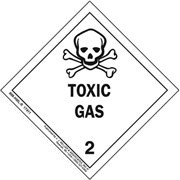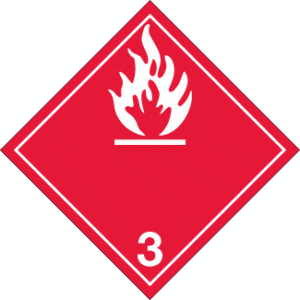45 the class or division hazard labels indicate
Marking and Labeling Flashcards - Quizlet A shipper offers to a motor carrier: 181 kg of a miscellaneous hazardous material (Class 9); 181 kg of a non-flammable gas in a non-bulk package (Division 2.2); and 363 kg of an oxidizer material in a non-bulk package (Division 5.1). What is the appropriate placard to affix to the motor vehicle? Dangerous Goods Classes and Symbols - ChemSafetyPro.COM Substances (including substances and mixtures), and articles are assigned to one of the following 9 classes according to the most predominant hazards they pose in transport. Some of the classes can be further divided into divisions, e.g., Class 1, while others do not have sub-divisions, e.g., Class 3. Class 1 Explosives Class 2 Gases
Hazardous Materials Markings labeling and Placarding Guide The appropriate hazard class or division number must be displayed in the lower corner of a primary and subsidiary hazard label [§172.402(b)]. • For classes 1,2, ...4 pages

The class or division hazard labels indicate
Hazmat Placards and UN Numbers: What You Need to Know Hazmat warning placards are broken down into nine different classifications, along with their divisions. Each class number is found at the bottom of the sign, while the division number can be found in the middle. Class 1 — Explosive Materials 1.1: Products with the potential to create a mass explosion Transportation of Dangerous Goods (TDG) - Classification When test results and the hazard class criteria are compared, there are three possible conclusions: a) The laboratory test results show the product does not meet any of the criteria for the hazard classes. In this case, the product is not TDG regulated and the product does not need to comply with the TDG Regulations. Classification of a Material Having More Than one Hazard - 49 CFR 173.2a 49 CFR 173.2a (c) identifies 5 HazMat with unique properties that preclude classification according to the procedures of 49 CFR 173.2a and must be classified according to other specific regulations; they include: Class 1 explosive materials. Division 5.2 Organic peroxide. Division 6.2 Infectious substance.
The class or division hazard labels indicate. DOT Hazard Classes - IAFC Placards are used to identify the class or division of a material. The hazard class or division number must be displayed in the lower corner of a placard and is required for both primary and subsidiary hazard classes and divisions, if applicable. Hazmat Table Flashcards | Quizlet alphabetically Fixes the proper shipping name, hazard class and packing group + Identifies proper shipping names for which one or more technical names must be entered in parentheses G Applies to materials intended for transportation by vessel W Applies to transportation by aircraft A Identifies material appropriate for domestic transportation D DOT Hazard Class Information - University of South Florida DOT Hazard Class Information. These are labels or placards that convey hazard information for containers or shipments of hazardous materials. Each label has a characteristic color pattern, pictogram, and hazard class number. There are nine different hazard classes under DOT. Click on the links below to see examples for each hazard class. GHS Hazard Classification: Everything You Need to Know A chemical will have a hazard class, and within that class are several hazard categories, of which one or more will apply. Section 2 of the new GHS Labels and SDSs require hazard statements which are determined by assigning a hazard class and category. As a manufacturer, importer, or distributor you'll need to know how to classify hazards.
Ch 3 Flashcards | Quizlet A Class 3, PGI substance that also meets the definition of a Class 8, PGII substance must be labeled _____. ... What is the primary hazard label listed in Column 6 of the HMT for Petroleum gases, liquefied? A. Flammable Gas 2.1. Required package markings for hazardous materials must be: A. Unobscured by labels or attachments. 49 CFR § 173.2 - Hazardous materials classes and index to hazard class ... § 173.2 Hazardous materials classes and index to hazard class definitions. The hazard class of a hazardous material is indicated either by its class (or division) number, its class name, or by the letters "ORM-D". 49 CFR § 172.402 - Additional labeling requirements. | CFR | US Law ... In addition to the label specified in column 6 of the § 172.101 table, each package of Class 1 material that also meets the definition for: (1) Division 6.1, Packing Groups I or II, shall be labeled POISON or POISON INHALATION HAZARD, as appropriate. (2) Class 7, shall be labeled in accordance with § 172.403 of this subpart. DOT Hazmat Labels, Placards, and Markings - A Guide The Department of Transportation has defined 9 Hazard Class Groups. They are separated by distinct hazardous properties and shipping requirements. Hazard Class 1 - Explosives Hazard Class 2 - Gases Hazard Class 3 - Flammable and Combustible Liquids Hazard Class 4 - Flammable Solids Hazard Class 5 - Oxidizing Substances, Organic Peroxide
Hazardous Materials Segregation Table from Labelmaster (1) The absence of any hazard class or division or a blank space in the table indicates that no restrictions apply. (2) The letter "X" in the table indicates that these materials may not be loaded, transported, or stored together in the same transport vehicle or storage facility during the course of transportation. PDF Hazard Classifications Used in Hazmat Table, Column 3 authorized by name in the Hazardous Materials Table or have been specifically authorized by name either in the Section 172.101 Hazardous Materials Table or have been assigned a shipping name and hazard class by the Associate Administrator for Hazardous Materials Safety. **Self-reactive materials that are thermally unstable and that 325 DOT Hazardous Materials Warning Labels and Markings - USPS DOT warning labels must meet the size and color requirements in 49 CFR §172.407 through 172.446 unless special authorization from the Manager, Product Classification is obtained as outlined in 325.1. Exhibit 325.2 DOT Hazardous Materials Warning Labels: PROHIBITED IN THE MAIL 325.3 Mailable Warning Labels 49 CFR -172.101 Hazardous Materials Table info - MaselliWeb The hazard class of a hazardous material is indicated either by its class (or division) number, its class name, or by the letters "ORM-D". The table contained in 173.2 lists the class numbers, division numbers, class or division names and those sections of the subchapter, which contain definitions for classifying hazardous materials, including forbidden materials.

Amazon.com: Hazardous Materials Labels - Class 2, Division 2.3 -- Inhalation Hazard - Vinyl (Pkg ...
Class 1 Dangerous Goods Explosive Substances and Articles Commonly transported Class 1 Dangerous Goods include ammunitions, fireworks, air bag inflactors and fuse, etc. Class 1 Dangerous Goods Label The picture below shows the hazard symbols (label) for Class 1 dangerous goods. More info about the marking and labelling of dangerous goods can be found here. Class 1 Explosives Class 2 Gases
PDF DOT CHART 16 Hazardous Materials Markings,Labeling and Placarding Guide each label represents a hazard of the material contained in the package [§172.401]. • For labeling mixed or consolidated packages, see §172.404. • The appropriate hazard class or division number must be displayed in the lower corner of a primary and subsidiary hazard label [§172.402(b)].
WHMIS 2015 - Hazard Classes and Categories : OSH Answers Each hazard class or category must use specific pictograms and other label elements to indicate the hazard that is present, and what precautionary measures must be taken. Use the information provided by the label and SDS to be informed and to know how to safely use, handle, store and dispose of the hazardous product.
SKS Bottle & Packaging, Hazardous Labels, Hazardous Labels, Hazard Class 6.2 "Infectious ...
DOT Hazard Classes - Hazmat University This hazard class is further broken down into three divisions: 2.1 Flammable gas (e.g. spray paint and lighters) 2.2 Non-flammable compressed gas (e.g. oxygen generators and shock absorbers) 2.3 Poisonous gas (e.g. Chlorine Gas and Phosgene Gas) Hazard Class 3 - Flammable Liquids Examples of common flammable liquids include perfumes and paint
PDF DOT CHART 15 Hazardous Materials Markings,Labeling and ... - Transportation each label represents a hazard of the material contained in the package [§172.401]. • For placard only if the specific IDlabeling mixed or consolidated packages, see §172.404. • The appropriate hazard class or division number must be displayed in the lower corner of a primary and subsidiary hazard label [§172.402(b)].
DANGEROUS GOODS CLASS LABELS - WorkSafe ACT Class 2.2 – Gases that are non flammable but may cause asphyxiation and/ or represent stored energy hazard. (Green background). Class 2.3 – Gases likely to ...2 pages
Know Your Hazard Symbols (Pictograms) | Office of Environmental Health ... The GHS system, part of OSHA's Hazard Communication Standard (HCS), consists of nine symbols, or pictograms, providing recognition of the hazards associated with certain substances. Use of eight of the nine are mandatory in the U.S., the exception being the environmental pictogram (see below). Each pictogram covers a specific type of hazard and ...
Dangerous goods classes and hazard labels - Civil Aviation Safety Authority Below are the 9 hazard labels for the 9 classes of dangerous goods. Class 1 Explosives Class 1 explosives This includes items such as: explosive substances pyrotechnic devices ammunition fireworks detonators. Class 2 Gases Class 2 gases These can be transported as compressed, liquefied, refrigerated liquefied or gas in solution.




Post a Comment for "45 the class or division hazard labels indicate"